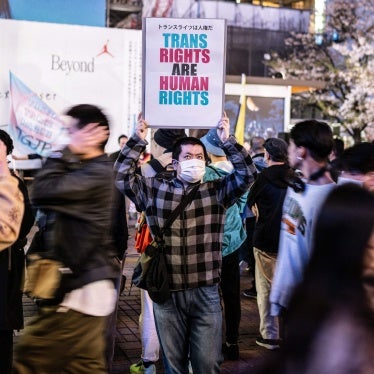Human Rights Watch is an independent, nongovernmental research and advocacy organization. We monitor human rights in more than 90 countries around the world, including Japan. We published a report in 2016 about access to education for lesbian, gay, bisexual and transgender (LGBT) students in Japanese schools.[1]
In its April 2016 “Guidebook for Teachers,” the Ministry of Education, Culture, Sports, Science and Technology (MEXT) signals a promising move toward inclusive education, stating: “It is possible that gender identity and sexual orientation are touched upon as part of human rights education.”[2] However, as our research with students, teachers, and school administrators across Japan found, mandatory requirements—and not mere suggestions—are necessary to make schools inclusive and safe for all students.
We encourage the government to eliminate material that perpetuates stereotypes and contributes to LGBT students being excluded from school. For example, both the elementary school and junior high school health curricula instruct that children, as they grow, naturally develop an attraction to the opposite sex. This should be revised to instruct that attraction to same-sex people is also a natural variation of human life.
Japan’s sex education policies and practices fall short of the approach recommended by the United Nations special rapporteur on education, UN human rights treaty bodies, and the UN Children’s Fund (UNICEF)—particularly when it comes to including information about sexual orientation and gender identity. One scholarly account of the sex education curriculum in Japan states, “young people are rarely provided with a comprehensive understanding of sexuality including … homosexuality.”[3] Other studies have found that Japanese textbooks display “a persistent tendency towards a conventional and stereotyped portrayal of gender identity and role.”[4] Between 2011 and 2013, Professor Yasuharu Hidaka surveyed nearly 6,000 teachers who taught kindergarten through high school across five municipalities in Japan. Between 63 and 73 percent of respondents indicated they thought LGBT issues should be included in the curriculum, yet less than 14 percent stated they had discussed LGBT issues in their classroom.[5] Japanese students told Human Rights Watch that, due to a lack of an LGBT-inclusive curriculum, the information they received from teachers about LGBT people was inaccurate and sometimes bigoted—based entirely on teachers’ personal views of sexuality and not on science or human rights.
Developing comprehensive and inclusive sexuality education programs is part of a state’s obligations to children’s and women’s rights. The Committee on the Rights of the Child frequently recommends to countries that they improve adolescent reproductive healthcare education policies.[6] The Committee on the Elimination of Discrimination against Women has also commented on the importance of comprehensive sex education, especially with regard to preventing the spread of HIV.[7] The UN special rapporteur on the right to education warned against sex education programs that are based exclusively on heterosexual relationships, because “by denying the existence of the lesbian, gay, transsexual, transgender and bisexual population, they expose these groups to risky and discriminatory practices.”[8] The curriculum should include information regarding sexual orientation, gender identity in sex education and civics curricula in line with standards set by the United Nations Educational, Scientific and Cultural Organization (UNESCO)[9] and the United Nations Population Fund (UNFPA).[10]
[1] Human Rights Watch, “The Nail That Sticks Out Gets Hammered Down: LGBT Bullying and Exclusion in Japanese Schools,” May 2016, https://www.hrw.org/report/2016/05/06/nail-sticks-out-gets-hammered-down/lgbt-bullying-and-exclusion-japanese-schools
[2] MEXT, “Guidebook for Teachers Regarding Careful Response to Students related to Gender Identity Disorder as well as Sexual Orientation and Gender Identity,” April 1, 2016, http://www.mext.go.jp/b_menu/houdou/28/04/1369211.htm.
[3] 2 Huiyan Fu, “The Bumpy Road to Socialise Nature: Sex Education in Japan,” Culture, Health & Sexuality: An International Journal for Research, Intervention and Care, vol. 13, no, 8 (June 2011): 903-915, accessed March 1, 2016, doi: 10.1080/13691058.2011.587894.
[4] Peter Cave, Primary School in Japan: Self, Individuality and Learning in Elementary Education (New York: Routledge, 2007).
[5] Yasuharu Hidaka, “An attitude survey for teachers on LGBT issues,” July 2014, http://www.healthissue.jp/teachers_lgbt_survey.pdf (accessed February 13, 2016).
[6] UN Committee on the Rights of the Child, “Concluding Observations: Albania,” CRC/C/15/Add.249 (2005), para. 57; UN Committee on the Rights of the Child, “Concluding Observations: Algeria,” CRC/C/15/Add.269 (2005), paras. 58, 59.
[7] UN CEDAW Committee, General Recommendation 15, Avoidance of discrimination against women in national strategies for the prevention and control of acquired immunodeficiency syndrome (AIDS), A/45/38 (1990).
[8] Report of the Special Rapporteur on the right to education, Kishore Singh, A/65/162, July 23, 2010, http://daccess-ddsny.un.org/doc/UNDOC/GEN/N10/462/13/PDF/N1046213.pdf?OpenElement (accessed March 1, 2016).
[9] UNESCO, “International Technical Guidance on Sexuality Education,” December 2009, http://unesdoc.unesco.org/images/0018/001832/183281e.pdf
[10] UNFPA, “UNFPA Operational Guidance for Comprehensive Sexuality Education,” 2014, http://www.unfpa.org/sites/default/files/pub-pdf/UNFPA_OperationalGuidance_WEB3.pdf








